Tsoulfanidis N. Measurement and detection of radiation
Подождите немного. Документ загружается.

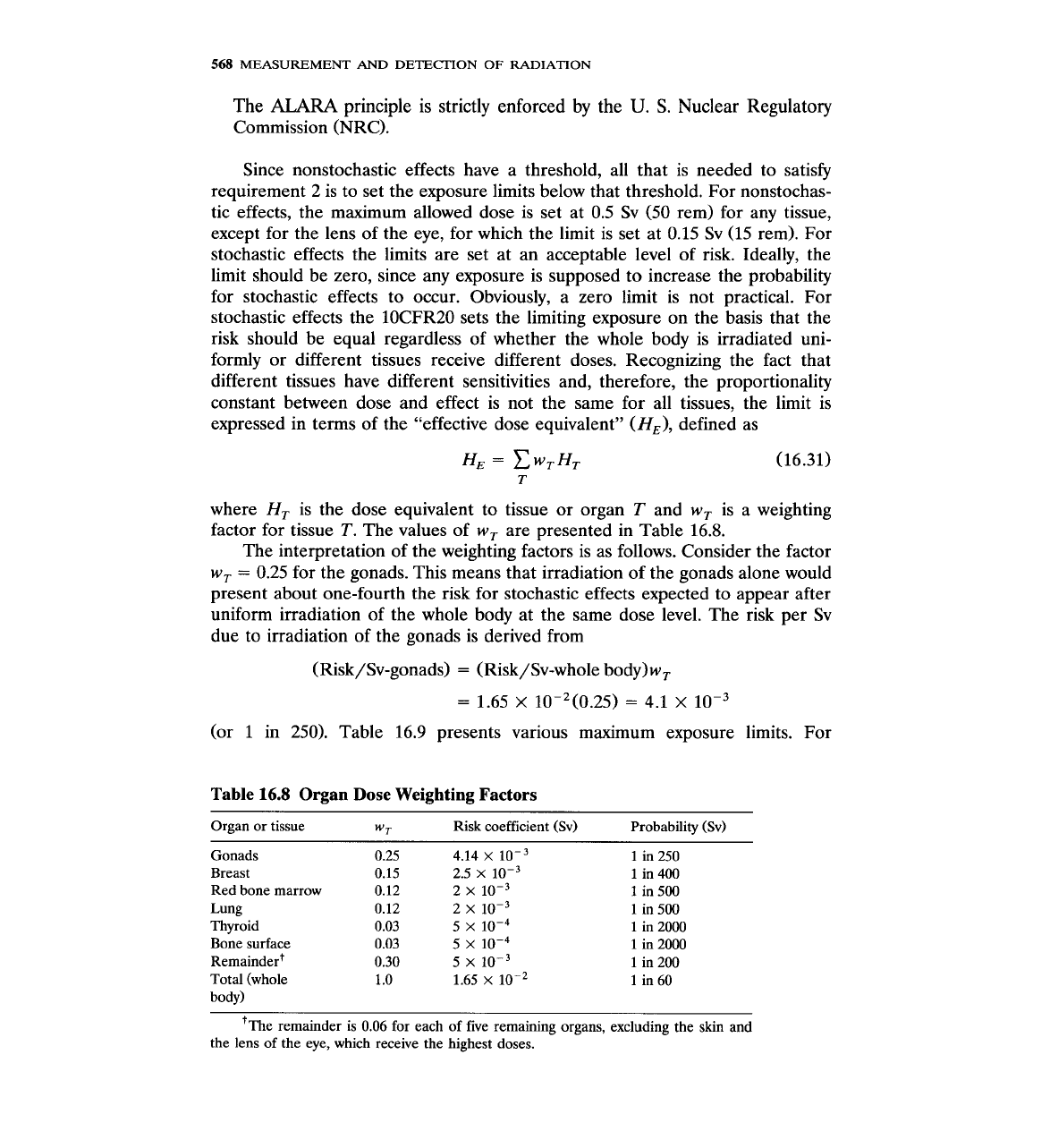
568
MEASUREMENT
AND
DETECTION
OF
RADIATION
The
ALARA
principle is strictly enforced by the
U.
S.
Nuclear Regulatory
Commission (NRC).
Since nonstochastic effects have a threshold, all that is needed to satisfy
requirement 2 is to set the exposure limits below that threshold. For
nonstochas-
tic effects, the maximum allowed dose is set at 0.5 Sv (50 rem) for any tissue,
except for the lens of the eye, for which the limit is set at 0.15 Sv (15 rem). For
stochastic effects the limits are set at an acceptable level of risk. Ideally, the
limit should be zero, since any exposure is supposed to increase the probability
for stochastic effects to occur. Obviously, a zero limit is not practical. For
stochastic effects the
10CFR20 sets the limiting exposure on the basis that the
risk should be equal regardless of whether the whole body is irradiated uni-
formly or different tissues receive different doses. Recognizing the fact that
different tissues have different sensitivities and, therefore, the proportionality
constant between dose and effect is not the same for all tissues, the limit is
expressed in terms of the "effective dose equivalent"
(HE),
defined as
where H, is the dose equivalent to tissue or organ
T
and w, is a weighting
factor for tissue
T.
The values of wT are presented in Table 16.8.
The interpretation of the weighting factors is as follows. Consider the factor
w,
=
0.25 for the gonads. This means that irradiation of the gonads alone would
present about one-fourth the risk for stochastic effects expected to appear after
uniform irradiation of the whole body at the same dose level. The risk per Sv
due to irradiation of the gonads is derived from
(Risk/Sv-gonads)
=
(Risk/Sv-whole bodylw,
=
1.65
x
1oP2(0.25)
=
4.1
X
(or
1
in 250). Table 16.9 presents various maximum exposure limits. For
Table
16.8
Organ Dose Weighting Factors
Organ or tissue
W
T
Risk coefficient (Sv) Probability (Sv)
Gonads
Breast
Red bone marrow
Lung
Thyroid
Bone surface
~emainder~
Total (whole
body)
tThe remainder is 0.06 for each of five remaining organs, excluding the skin and
the lens of the eye, which receive the highest doses.
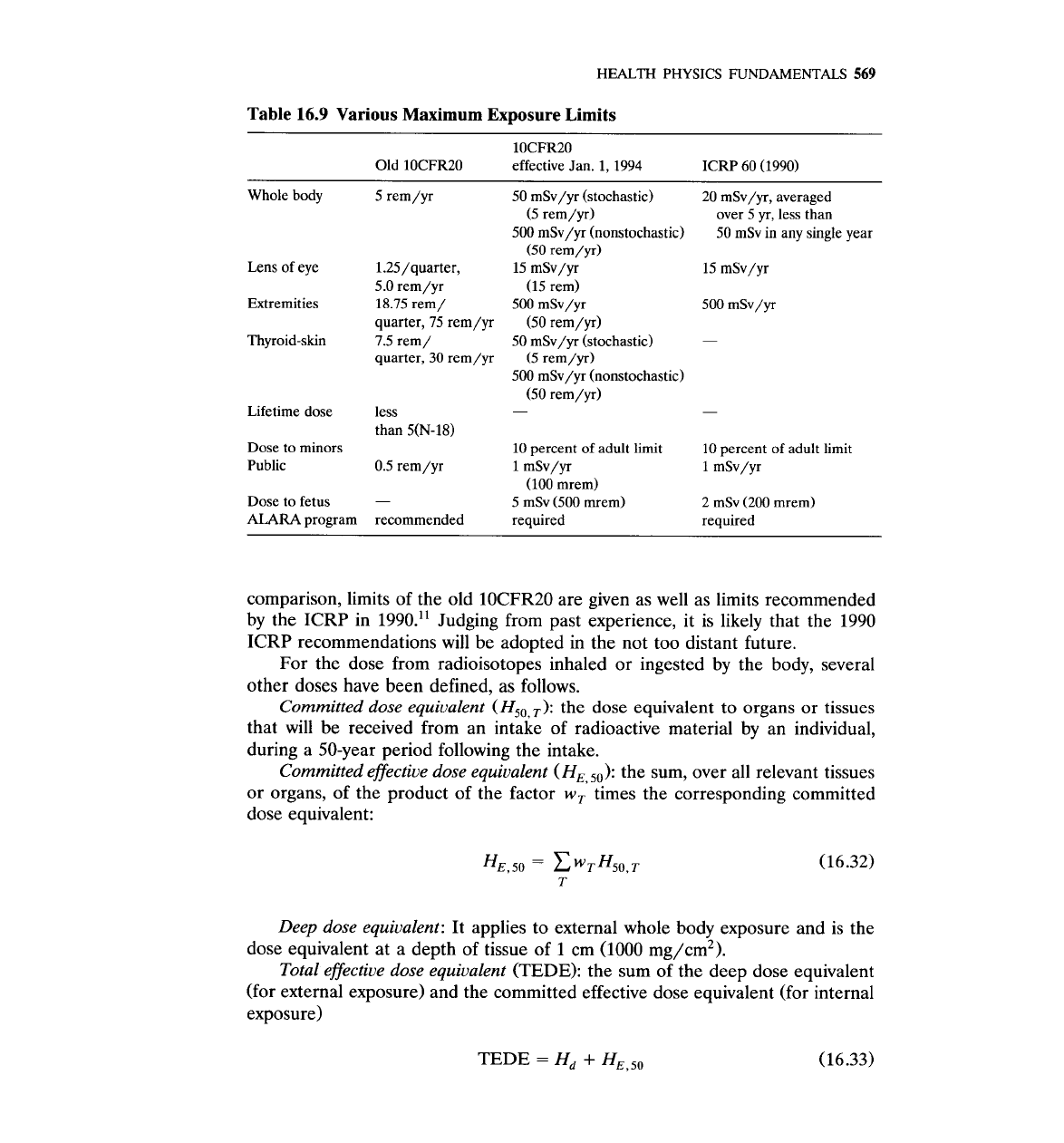
HEALTH PHYSICS
FUNDAMENTALS
569
Table
16.9
Various Maximum Exposure Limits
10CFR20
Old 10CFR20 effective Jan. 1, 1994 ICRP 60 (1990)
Whole body 5 rem/yr
Lens of eye 1.25/quarter,
5.0 rem/yr
Extremities 18.75 rem/
quarter, 75 rem/yr
Thyroid-skin 7.5 rem/
quarter, 30 rem/yr
Lifetime dose less
than 5(N-18)
Dose to minors
Public 0.5
rem/yr
Dose to fetus
-
ALARA
program recommended
50 mSv/yr (stochastic)
20
mSv/yr, averaged
(5 rem/yr)
over 5 yr, less than
500 mSv/yr (nonstochastic) 50 mSv in any single year
(50 rem/yr)
15 mSv/yr 15 mSv/yr
(15 rem)
500 mSv/yr 500 mSv/yr
(50 rem/yr)
50 mSv/yr (stochastic)
-
(5 rem/yr)
500 mSv/yr (nonstochastic)
(50 rem/yr)
10 percent of adult limit
10 percent of adult limit
1 mSv/yr
1
mSv/yr
(100 mrem)
5 mSv (500 mrem)
2 mSv (200 mrem)
required required
comparison, limits of the old 10CFR20 are given as well as limits recommended
by the ICRP in 1990." Judging from past experience, it is likely that the 1990
ICRP
recommendations will be adopted in the not too distant future.
For the dose from radioisotopes inhaled or ingested by the body, several
other doses have been defined, as follows.
Committed dose equivalent
(H50,T):
the dose equivalent to organs or tissues
that will be received from an intake of radioactive material by an individual,
during a 50-year period following the intake.
Committed effective dose equivalent
(HE, ,,): the sum, over all relevant tissues
or organs, of the product of the factor
w,
times the corresponding committed
dose equivalent:
Deep dose equivalent:
It applies to external whole body exposure and is the
dose equivalent at a depth of tissue of
1
cm (1000 mg/cm2).
Total effective dose equivalent
(TEDE): the sum of the deep dose equivalent
(for external exposure) and the committed effective dose equivalent (for internal
exposure)
TEDE
=
Hd
+
HE,50 (16.33)
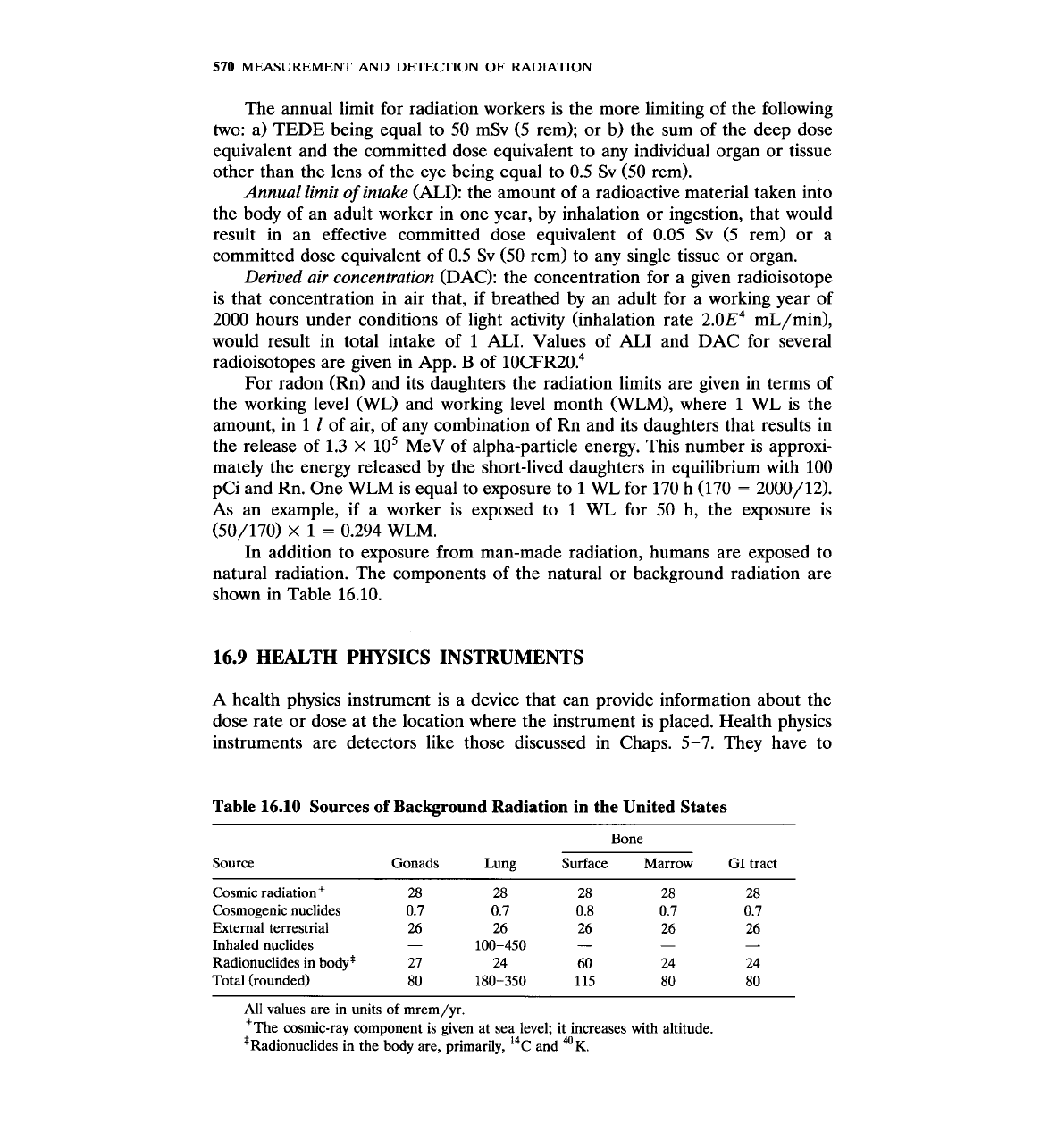
570
MEASUREMENT
AND
DETECTlON OF
RADIATION
The annual limit for radiation workers is the more limiting of the following
two: a) TEDE being equal to 50 mSv (5 rem); or b) the sum of the deep dose
equivalent and the committed dose equivalent to any individual organ or tissue
other than the lens of the eye being equal to 0.5 Sv (50 rem).
Annual limit of intake
(ALI): the amount of a radioactive material taken into
the body of an adult worker in one year, by inhalation or ingestion, that would
result in an effective committed dose equivalent of
0.05
Sv
(5
rem) or a
committed dose equivalent of 0.5 Sv (50 rem) to any single tissue or organ.
Derived air concentration
(DAC): the concentration for a given radioisotope
is that concentration in air that, if breathed by an adult for a working year of
2000 hours under conditions of light activity (inhalation rate 2.0~~ mL/min),
would result in total intake of
1
ALI. Values of ALI and DAC for several
radioisotopes are given in App.
B
of 10~~~20.~
For radon (Rn) and its daughters the radiation limits are given in terms of
the working level
(WL) and working level month (WLM), where
1
WL is the
amount, in
1
I
of air, of any combination of Rn and its daughters that results in
the release of 1.3
X
lo5
MeV of alpha-particle energy. This number is approxi-
mately the energy released by the short-lived daughters in equilibrium with 100
pCi and Rn. One WLM is equal to exposure to
1
WL for 170 h (170
=
2000/12).
As
an example, if a worker is exposed to
1
WL for 50 h, the exposure is
(50/170)
X
1
=
0.294 WLM.
In addition to exposure from man-made radiation, humans are exposed to
natural radiation. The components of the natural or background radiation are
shown in Table 16.10.
16.9
HEALTH PHYSICS INSTRUMENTS
A
health physics instrument is a device that can provide information about the
dose rate or dose at the location where the instrument is placed. Health physics
instruments are detectors like those discussed in Chaps. 5-7. They have to
Table 16.10 Sources of Background Radiation in the United States
Bone
Source Gonads Lung Surface Marrow GI tract
Cosmic radiation+
28 28
28 28 28
Cosmogenic nuclides
0.7 0.7 0.8 0.7 0.7
External terrestrial
26 26 26 26 26
Inhaled nuclides
-
100-450
-
-
Radionuclides in bodyt
27 24 60 24 24
Total (rounded)
80 180-350
115
80 80
All values are in units of mrem/yr.
?he cosmic-ray component is given at sea level; it increases with altitude.
'~adionuclides in the body are, primarily,
14c
and
40~.
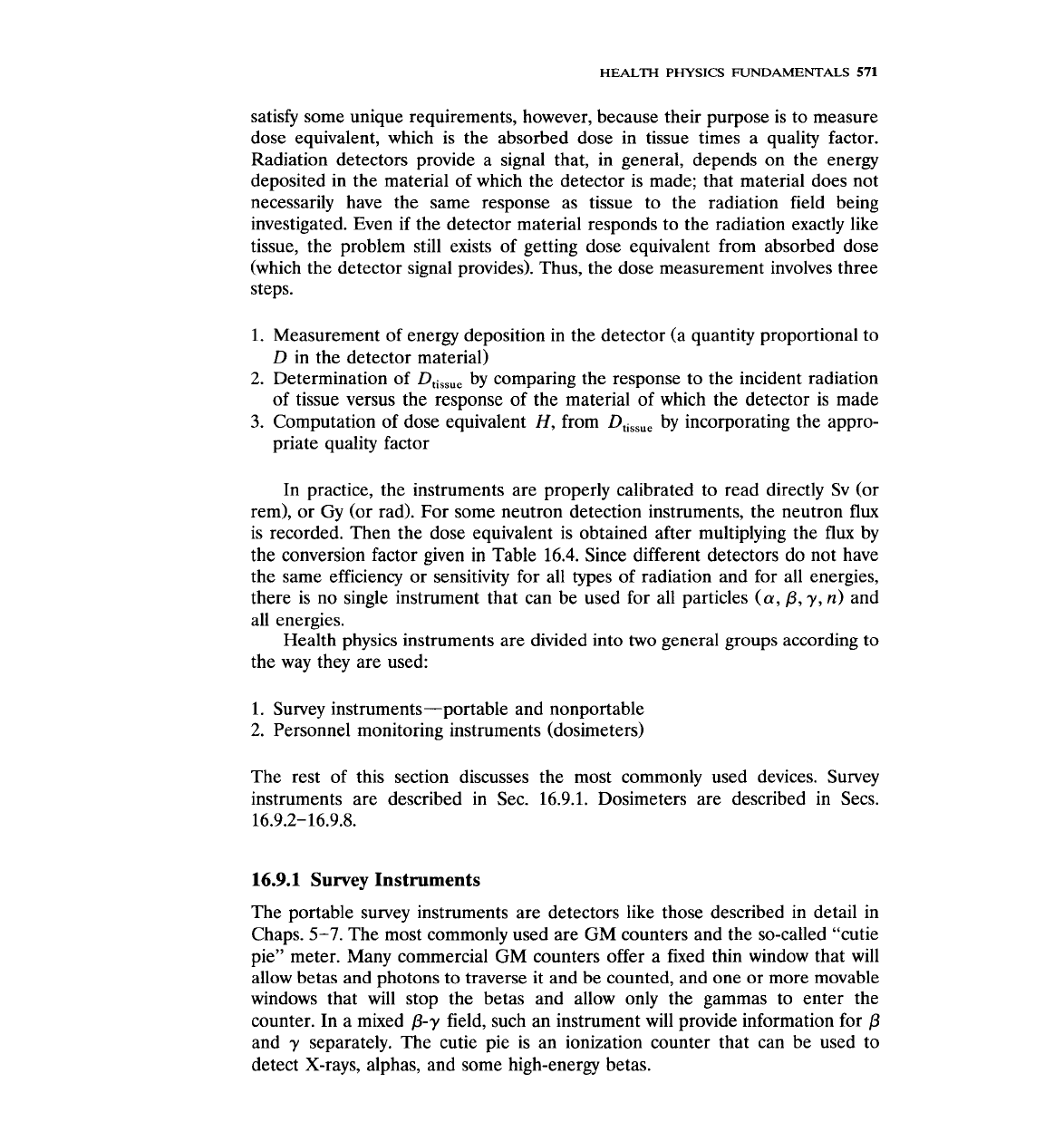
HEALTH
PHYSICS
FUNDAMENTALS
571
satisfy some unique requirements, however, because their purpose is to measure
dose equivalent, which is the absorbed dose in tissue times a quality factor.
Radiation detectors provide a signal that, in general, depends on the energy
deposited in the material of which the detector is made; that material does not
necessarily have the same response as tissue to the radiation field being
investigated. Even if the detector material responds to the radiation exactly like
tissue, the problem still exists of getting dose equivalent from absorbed dose
(which the detector signal provides). Thus, the dose measurement involves three
steps.
1.
Measurement of energy deposition in the detector (a quantity proportional to
D
in the detector material)
2. Determination of
DtisSu,
by comparing the response to the incident radiation
of tissue versus the response of the material of which the detector is made
3.
Computation of dose equivalent
H,
from
Dtissu,
by incorporating the appro-
priate quality factor
In practice, the instruments are properly calibrated to read directly Sv (or
rem), or Gy (or rad). For some neutron detection instruments, the neutron
flux
is recorded. Then the dose equivalent is obtained after multiplying the
flux
by
the conversion factor given in Table 16.4. Since different detectors do not have
the same efficiency or sensitivity for all types of radiation and for all energies,
there is no single instrument that can be used for all particles
(a,
P,
y,
n)
and
all energies.
Health physics instruments are divided into two general groups according to
the way they are used:
1.
Survey instruments-portable and nonportable
2.
Personnel monitoring instruments (dosimeters)
The rest of this section discusses the most commonly used devices. Survey
instruments are described in Sec. 16.9.1. Dosimeters are described in Secs.
16.9.2-16.9.8.
16.9.1
Survey Instruments
The portable survey instruments are detectors like those described in detail in
Chaps.
5-7.
The most commonly used are GM counters and the so-called "cutie
pie" meter. Many commercial GM counters offer a fixed thin window that will
allow betas and photons to traverse it and be counted, and one or more movable
windows that will stop the betas and allow only the gammas to enter the
counter. In a mixed
P-y
field, such an instrument will provide information for
P
and
y
separately. The cutie pie is an ionization counter that can be used to
detect X-rays, alphas, and some high-energy betas.
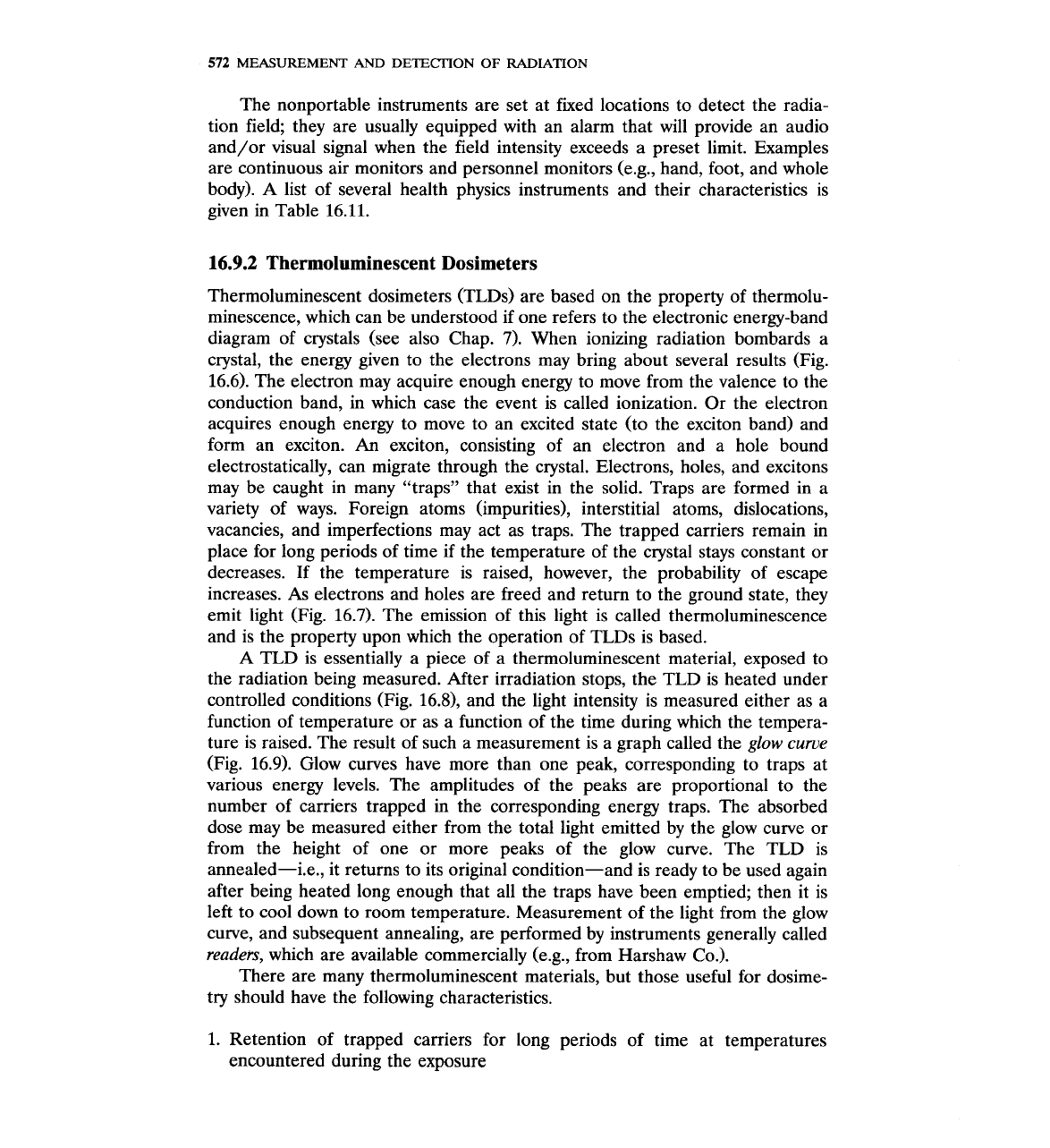
572
MEASUREMENT
AND DETECITON OF
RADIATION
The nonportable instruments are set at fixed locations to detect the radia-
tion field; they are usually equipped with an alarm that will provide an audio
and/or visual signal when the field intensity exceeds a preset limit. Examples
are continuous air monitors and personnel monitors
(e.g., hand, foot, and whole
body). A list of several health physics instruments and their characteristics is
given in Table 16.11.
16.9.2
Thermoluminescent Dosimeters
Thermoluminescent dosimeters (TLDs) are based on the property of thermolu-
minescence, which can be understood if one refers to the electronic energy-band
diagram of crystals (see also Chap. 7). When ionizing radiation bombards a
crystal, the energy given to the electrons may bring about several results (Fig.
16.6). The electron may acquire enough energy to move from the valence to the
conduction band, in which case the event is called ionization. Or the electron
acquires enough energy to move to an excited state (to the exciton band) and
form an exciton.
An
exciton, consisting of an electron and a hole bound
electrostatically, can migrate through the crystal. Electrons, holes, and excitons
may be caught in many "traps" that exist in the solid. Traps are formed in a
variety of ways. Foreign atoms (impurities), interstitial atoms, dislocations,
vacancies, and imperfections may act as traps. The trapped carriers remain in
place for long periods of time if the temperature of the crystal stays constant or
decreases. If the temperature is raised, however, the probability of escape
increases. As electrons and holes are freed and return to the ground state, they
emit light (Fig. 16.7). The emission of this light is called thermoluminescence
and is the property upon which the operation of TLDs is based.
A
TLD is essentially a piece of a thermoluminescent material, exposed to
the radiation being measured. After irradiation stops, the TLD is heated under
controlled conditions (Fig. 16.8), and the light intensity is measured either as a
function of temperature or as a function of the time during which the tempera-
ture is raised. The result of such a measurement is a graph called the
glow
curve
(Fig. 16.9). Glow curves have more than one peak, corresponding to traps at
various energy levels. The amplitudes of the peaks are proportional to the
number of carriers trapped in the corresponding energy traps. The absorbed
dose may be measured either from the total light emitted by the glow curve or
from the height of one or more peaks of the glow curve. The TLD is
annealed-i.e., it returns to its original condition-and is ready to be used again
after being heated long enough that all the traps have been emptied; then it is
left to cool down to room temperature. Measurement of the light from the glow
curve, and subsequent annealing, are performed by instruments generally called
readers, which are available commercially
(e.g., from Harshaw Co.).
There are many thermoluminescent materials, but those useful for dosime-
try should have the following characteristics.
1.
Retention of trapped carriers for long periods of time at temperatures
encountered during the exposure
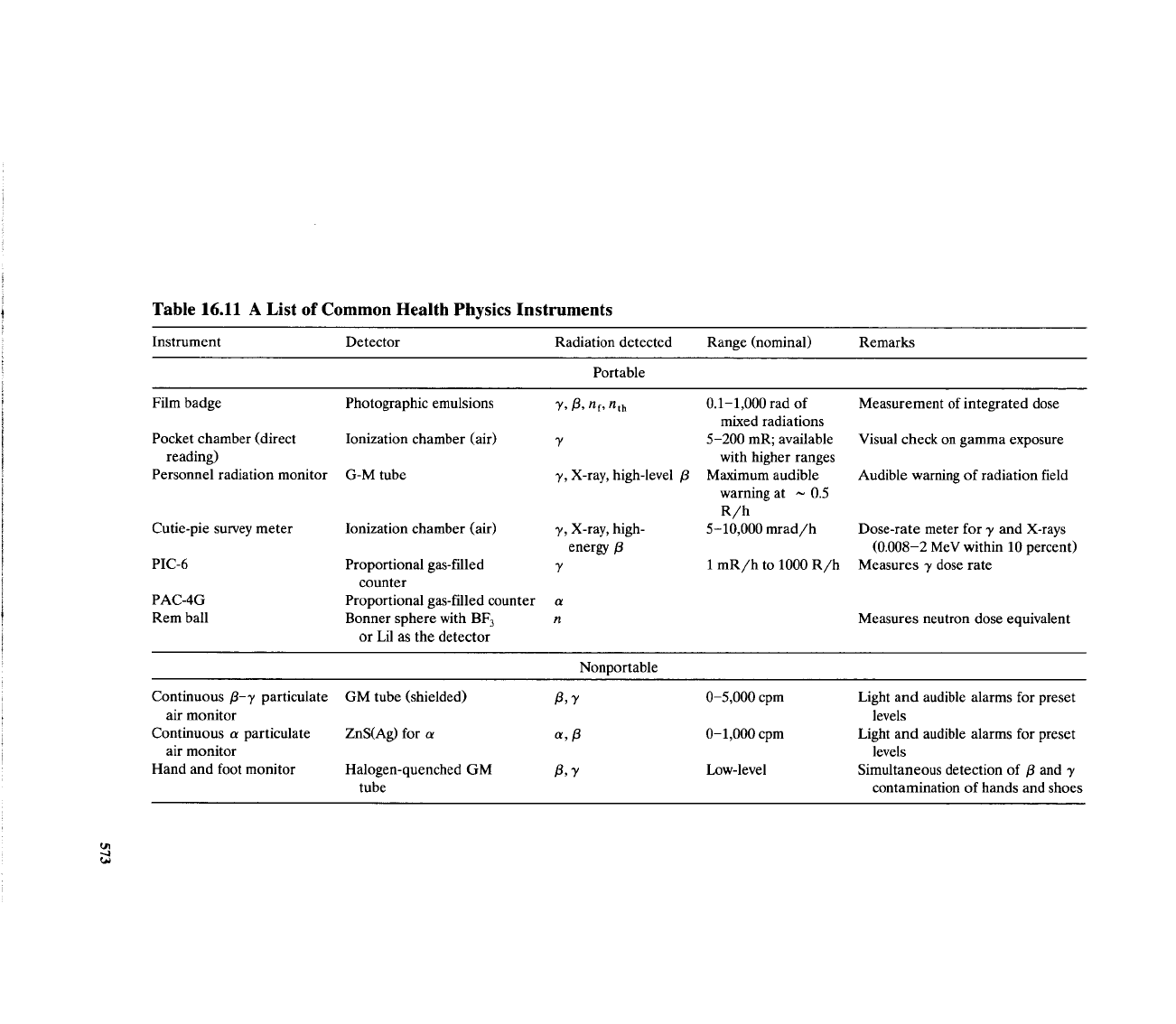
Table
16.11
A
List of Common Health Physics Instruments
Instrument Detector Radiation detected Range (nominal) Remarks
Portable
Film badge
Pocket chamber (direct
reading)
Personnel radiation monitor
Cutie-pie survey meter
PIC-6
PAC-4G
Rem ball
Photographic emulsions
Ionization chamber (air)
G-M tube
Ionization chamber (air)
Proportional gas-filled
counter
Proportional gas-filled counter
Bonner sphere with
BF,
or Lil as the detector
y,
X-ray, high-level
P
y,
X-ray, high-
energy
P
Y
0.1-1,000
rad of
mixed radiations
5-200
mR; available
with higher ranges
Maximum audible
warning at
-
0.5
R/h
5-10,000
mrad/h
-
-
Measurement of integrated dose
Visual check on gamma exposure
Audible warning of radiation field
Dose-rate meter for
y
and X-rays
(0.008-2
MeV within
10
percent)
Measures
y
dose rate
Measures neutron dose equivalent
Nonportable
Continuous
P-
y
particulate GM tube (shielded)
P3
Y
air monitor
Continuous
a
particulate ZnS(Ag) for
a
a,
P
air monitor
Hand and foot monitor Halogen-quenched
GM
P,
Y
tube
0-5,000
cpm Light and audible alarms for preset
levels
0-1,000
cpm Light and audible alarms for preset
levels
Low-level Simultaneous detection of
p
and
y
contamination of hands and shoes
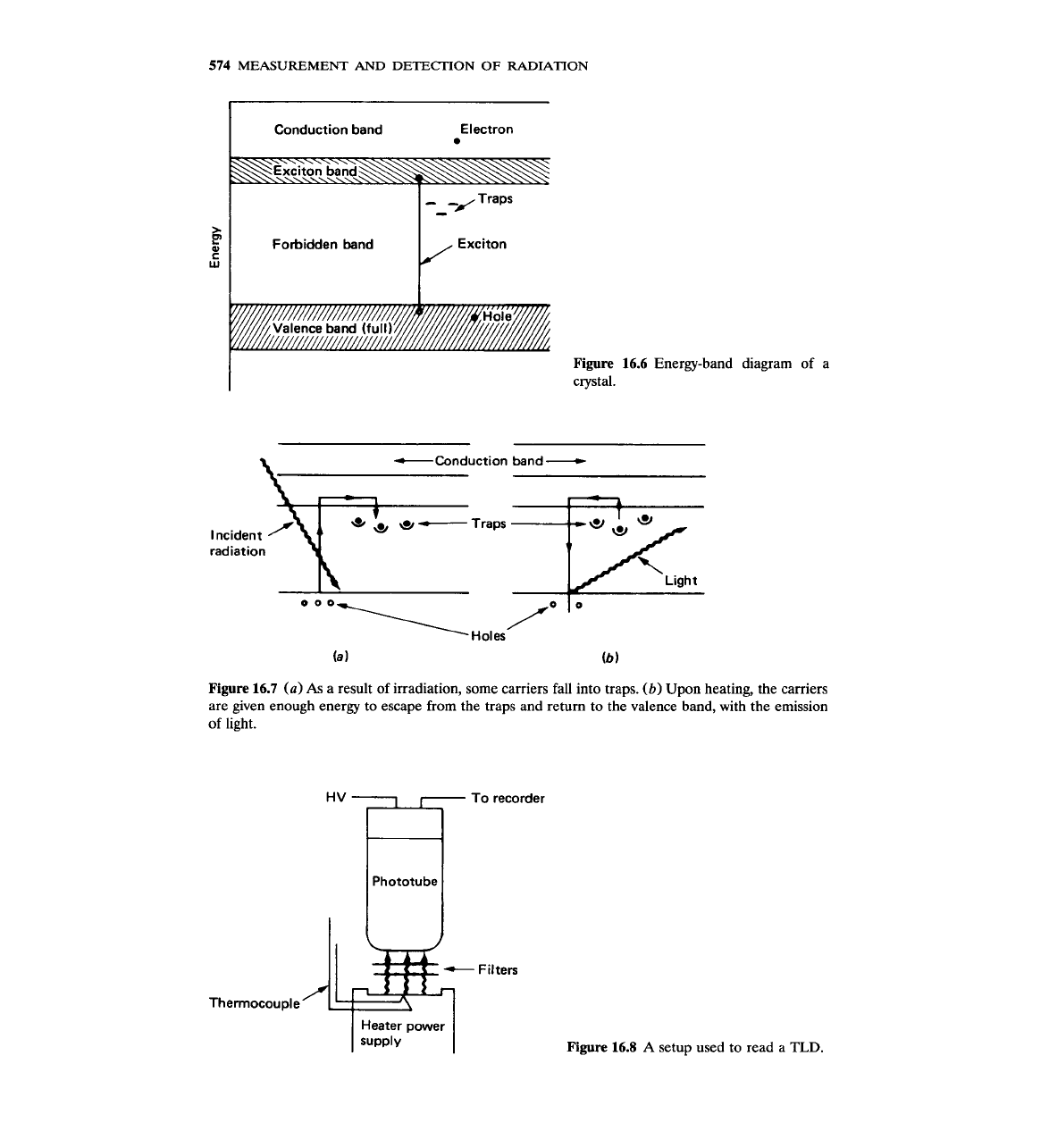
574
MEASUREMENT AND DETECTION OF RADIATION
Conduction band Electron
0
Figure
16.6 Energy-band diagram of a
crystal.
band
-
Incident
radiation
Light
OoO\
Holes
yo'o
(a
I
(6
I
Figure
16.7
(a)
As
a result of irradiation, some carriers fall into traps.
(b)
Upon heating, the carriers
are given enough energy to escape from the traps and return to the valence band, with the emission
of light.
Heater power
supply
Figure
16.8
A
setup used to read a
TLD.
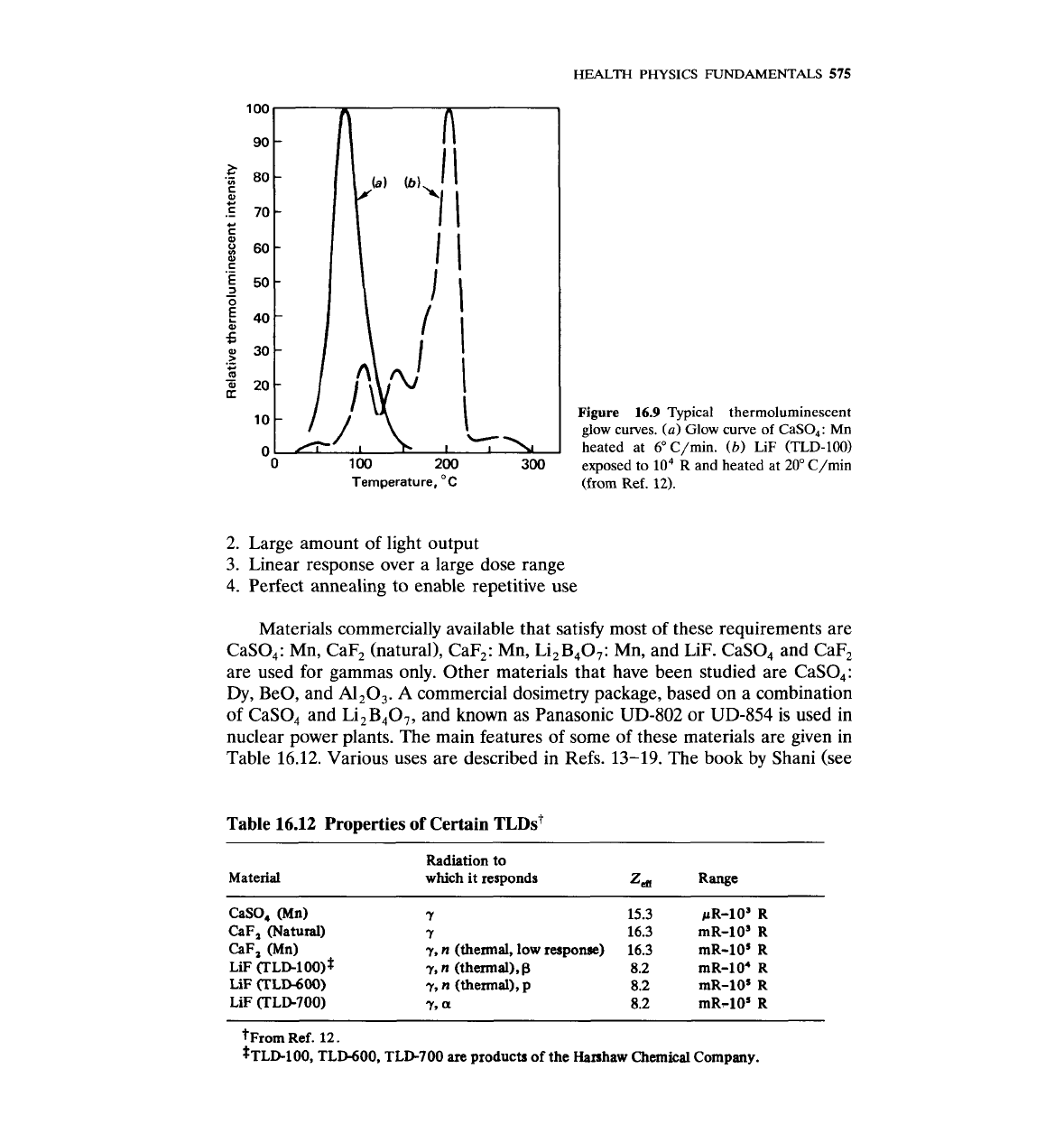
HEALTH
PHYSICS
FUNDAMENTALS
575
Figure
16.9
Typical thermoluminescent
glow curves.
(a)
Glow curve of CaSO,: Mn
heated at 6"C/min.
(b)
LiF
(TLD-100)
-
0
100
200
300
exposed to
lo4
R
and heated
at
20'
C/min
Temperature,
"C
(from Ref.
12).
2. Large amount of light output
3. Linear response over a large dose range
4.
Perfect annealing to enable repetitive use
Materials commercially available that satisfy most of these requirements are
CaSO,: Mn, CaF, (natural), CaF,: Mn, Li2B407: Mn, and LiF. CaSO, and CaF,
are used for gammas only. Other materials that have been studied are CaSO,:
Dy,
BeO, and
A120,.
A
commercial dosimetry package, based on a combination
of CaSO, and Li2B407, and known as Panasonic UD-802 or UD-854 is used in
nuclear power plants. The main features of some of these materials are given in
Table 16.12. Various uses are described in Refs. 13-19. The book by Shani (see
Table
16.12
Properties of Certain TLDst
Material
Radiation to
which it responds
Z,
Range
CaSO, (Mn)
r
15.3 pR-lo3 R
CaF, (Natural)
7
16.3 mR-10' R
CaF,
(Mn)
r,
n
(thermal,
low
response)
16.3 m~-l0'
R
LiF (T~D-100)*
r,
n
(thermal).
B
8.2 rn~-10~
R
LiF ULD600)
r,
n
(thermal),
P
8.2 rn~-lo'
R
LiF (TLD700)
7.
a
8.2 m~-10'
R
t~rom Ref. 12.
$TLD~OO, TLIMOO, TLD-700
are
products of the Harshaw Chemical Company.
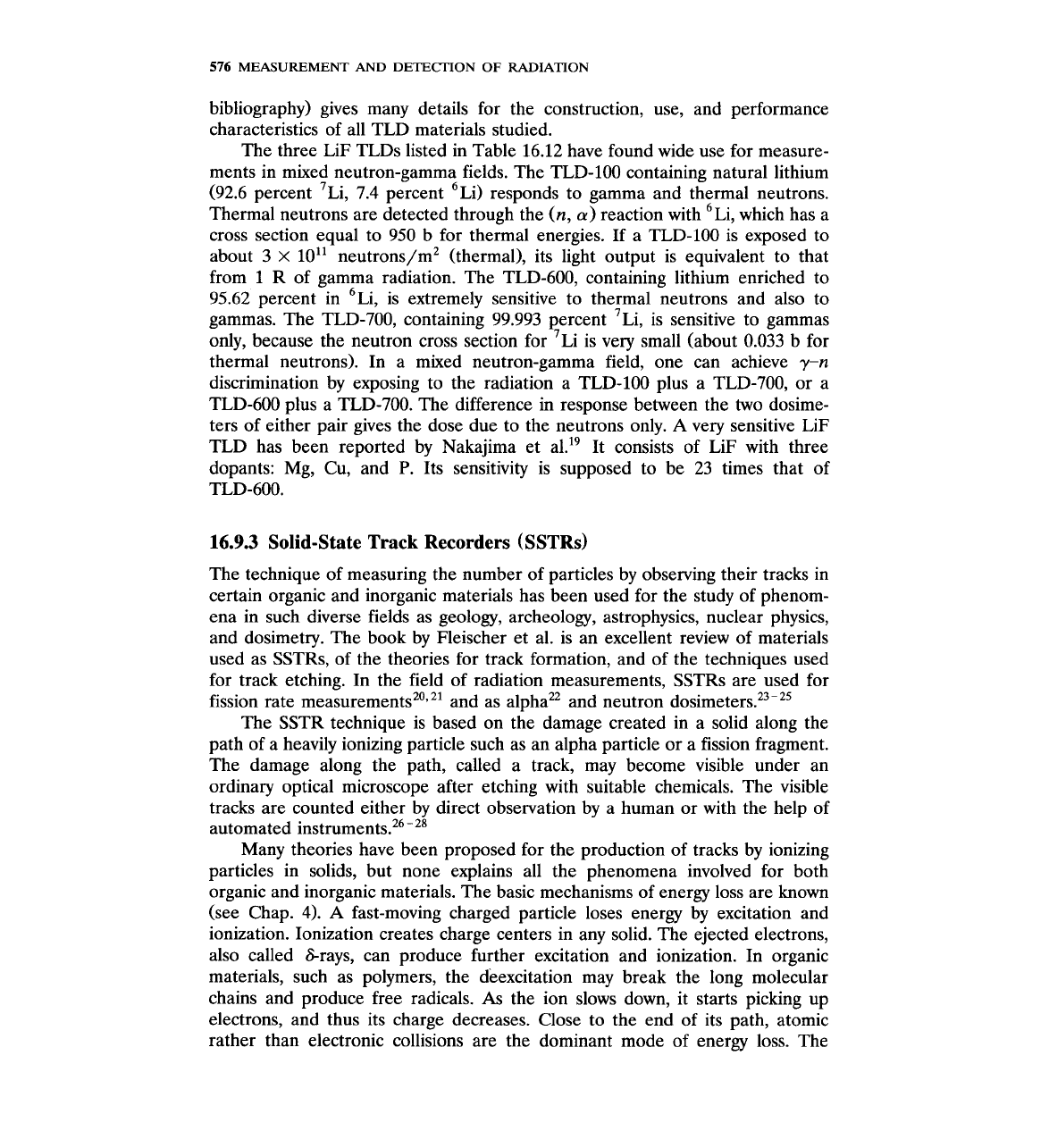
576
MEASUREMENT
AND
DETECTION
OF
RADIATION
bibliography) gives many details for the construction, use, and performance
characteristics of all TLD materials studied.
The three LiF TLDs listed in Table 16.12 have found wide use for measure-
ments in mixed neutron-gamma fields. The TLD-100 containing natural lithium
(92.6 percent 7~i, 7.4 percent 6~i) responds to gamma and thermal neutrons.
Thermal neutrons are detected through the
(n,
a)
reaction with 6~i, which has a
cross section equal to 950 b for thermal energies. If a TLD-100 is exposed to
about 3
x
1011 neutrons/m2 (thermal), its light output is equivalent to that
from
1
R of gamma radiation. The TLD-600, containing lithium enriched to
95.62 percent in 6~i, is extremely sensitive to thermal neutrons and also to
gammas. The TLD-700, containing 99.993 percent 7~i, is sensitive to gammas
only, because the neutron cross section for 7~i is very small (about 0.033 b for
thermal neutrons). In a mixed neutron-gamma field, one can achieve
y-n
discrimination by exposing to the radiation a TLD-100 plus a TLD-700, or a
TLD-600 plus a TLD-700. The difference in response between the two dosime-
ters of either pair gives the dose due to the neutrons only.
A
very sensitive LiF
TLD has been reported by Nakajima et al.19 It consists of LiF with three
dopants: Mg, Cu, and
P.
Its sensitivity is supposed to be 23 times that of
TLD-600.
16.9.3
Solid-state Track Recorders (SSTRs)
The technique of measuring the number of particles by observing their tracks in
certain organic and inorganic materials has been used for the study of phenom-
ena in such diverse fields as geology, archeology, astrophysics, nuclear physics,
and dosimetry. The book by Fleischer et al. is an excellent review of materials
used as SSTRs, of the theories for track formation, and of the techniques used
for track etching. In the field of radiation measurements, SSTRs are used for
fission rate measurernent~~~.~~ and as alphaz2 and neutron
dosimeter^.'^-^^
The SSTR technique is based on the damage created in a solid along the
path of a heavily ionizing particle such as an alpha particle or a fission fragment.
The damage along the path, called a track, may become visible under an
ordinary optical microscope after etching with suitable chemicals. The visible
tracks are counted either by direct observation by a human or with the help of
automated
instrument^.^^-^^
Many theories have been proposed for the production of tracks by ionizing
particles in solids, but none explains all the phenomena involved for both
organic and inorganic materials. The basic mechanisms of energy loss are known
(see Chap.
4).
A
fast-moving charged particle loses energy by excitation and
ionization. Ionization creates charge centers in any solid. The ejected electrons,
also called Grays, can produce further excitation and ionization. In organic
materials, such as polymers, the deexcitation may break the long molecular
chains and produce free radicals.
As
the ion slows down, it starts picking up
electrons, and thus its charge decreases. Close to the end of its path, atomic
rather than electronic collisions are the dominant mode of energy loss. The
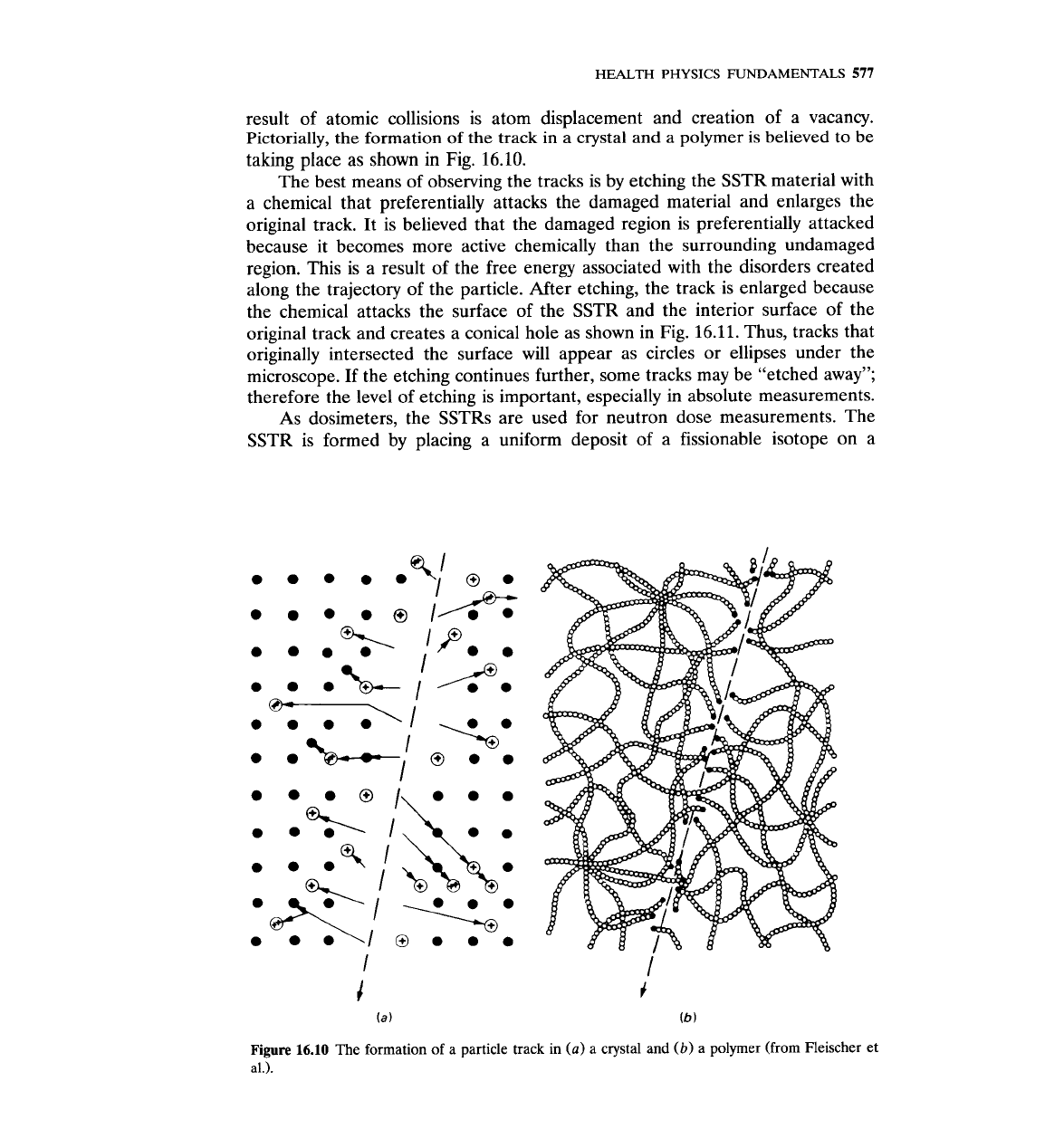
HEALTH
PHYSICS FUNDAMENTALS
577
result of atomic collisions is atom displacement and creation of a vacancy.
Pictorially, the formation of the track in a crystal and a polymer is believed to be
taking place as shown in Fig.
16.10.
The best means of observing the tracks is by etching the
SSTR
material with
a chemical that preferentially attacks the damaged material and enlarges the
original track. It is believed that the damaged region is preferentially attacked
because it becomes more active chemically than the surrounding undamaged
region. This is a result of the free energy associated with the disorders created
along the trajectory of the particle. After etching, the track is enlarged because
the chemical attacks the surface of the SSTR and the interior surface of the
original track and creates a conical hole as shown in Fig.
16.11.
Thus, tracks that
originally intersected the surface will appear as circles or ellipses under the
microscope. If the etching continues further, some tracks may be "etched away";
therefore the level of etching is important, especially in absolute measurements.
As dosimeters, the SSTRs are used for neutron dose measurements. The
SSTR is formed by placing a uniform deposit of a fissionable isotope on a
Figure
16.10
The formation of a particle track
in
(a)
a crystal and
(b)
a polymer (from Fleischer et
all
